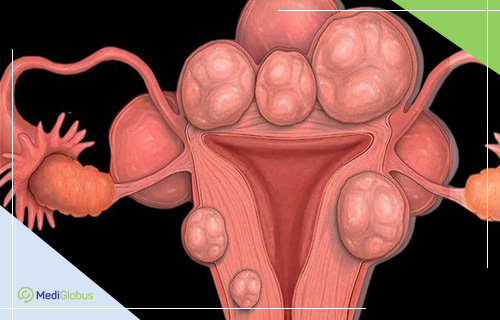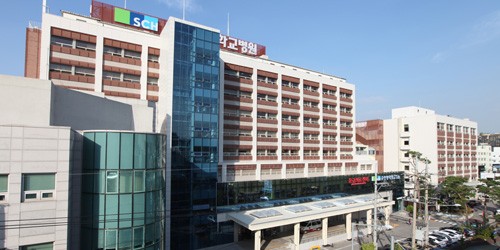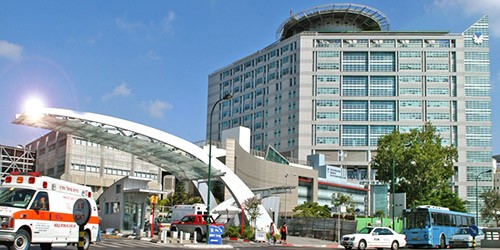1. Causes of uterine sarcoma |
2. Symptoms of uterine sarcoma |
3. Diagnosis of sarcoma |
4. Treatment of sarcoma |
5. Prognosis for survival |
6. Leading clinics abroad |
7. Patient testimonial |
Uterine sarcoma is a malignant tumour of the body of the uterus. It is quite aggressive and needs immediate treatment. Patients with stages 1 and 2 of the disease have the best prognosis for survival. At this stage, it is the easiest to treat. Timely diagnosis and comprehensive treatment can successfully confront and control the pathology.
Read about the treatment of uterine sarcomas abroad and how effective it is in our article.
Listen to the article:
What is uterine sarcoma and why does it appear?
Uterine sarcoma is a malignant neoplasm of non-epithelial origin. It accounts for about 6% of all tumours in the organ and less than 1% of all genital cancers. The disease is caused by abnormal growth and degeneration of the muscular or connective tissue of the myometrium, as well as the stroma of the mucous membrane of the organ, mesenchymal or undifferentiated cells. The exact causes of sarcoma are not known, but the main risk factors are:
late menstruation and childbirth;
trauma from diagnostic curettage;
prolonged hormone therapy;
blood relatives with sarcoma;
chronic inflammatory diseases of the uterus;
radiotherapy of the pelvic organs;
termination of pregnancy;
late menopause.
Many women think that myoma degenerating into sarcoma is one of the main causes of the disease. But this is far from the case. The risk of benign myoma turning into cancer for patients of childbearing age is 0.25-0.75%, and around 1% during menopause and postmenopause.
Uterine sarcoma is more commonly diagnosed in the menopausal or post-menopausal period. The average age of patients is 45-55 years. Most patients are diagnosed with endometrial stromal tumours. They account for about half of all cases of uterine sarcoma. Adenosarcomas, carcinosarcomas, and leiomyosarcomas are also often found. Each of these tumours has a different prognosis for oncotherapy.

Symptoms of uterine sarcoma
Uterine sarcoma does not have any specific symptoms. The clinical picture is varied. It can be similar to myoma or uterine fibroma as well as other abnormalities of the uterus. The initial stages of the disease are asymptomatic. As the malignant process progresses, patients encounter:
pain in the lower abdomen;
vaginal bleeding during the intermenstrual period;
discomfort during intercourse;
increased abdominal volume;
irregular menstruations;
increased fatigue and weakness;
weight loss;
nausea;
anaemia.
How is uterine sarcoma diagnosed?
For a long time, sarcoma may not manifest itself at all or it may cause minor discomfort that women often do not pay attention to. For this reason, only one-third of patients are diagnosed with the tumour at an early stage. The following examinations can be used to detect the disease:
transvaginal ultrasound,
magnetic resonance imaging,
hysterosalpingography,
diagnostic curettage of the uterine cavity,
ultrasound or CT-guided biopsy.
For the early detection of sarcoma, regular comprehensive gynaecological check-ups are essential. This allows women to assess the state of their reproductive system and detect a malignant process at the very beginning of its development. To make an appointment for a check-up abroad, please contact MediGlobus.
What are the most effective treatments for uterine sarcoma abroad?
A comprehensive approach to the treatment of uterine sarcoma can improve survival rates. Techniques used to fight the disease include surgery, radiation, chemo, hormonal or targeted therapies. The key and most effective option is surgery:
hysterectomy: removal of the uterus and cervix;
total hysterectomy with salpingo-oophorectomy: removal of the affected uterus and one or both ovaries and fallopian tubes;
radical hysterectomy: removal of the uterus, cervix, both ovaries, both fallopian tubes and some surrounding tissue;
lymphadenectomy: removal of lymph nodes.

Removal of uterine sarcomas is performed laparoscopically (through 3-5 punctures) and laparotomically (long incision). The type of intervention is determined by the degree of spread of the malignant process. The duration of the operation is 1-3 hours.
After sarcoma removal, women are prescribed chemotherapy or radiation. These methods are often combined. The drugs are given intravenously or given as pills. The number of courses is determined for each patient individually. Radiation therapy for uterine sarcoma can be internal (the radiation agent is placed in the body) or external (delivered by a machine outside the body).
Hormone and targeted therapy can be recommended for some patients. Hormonal treatment is used to stop tumour growth by blocking the hormonal receptors. For uterine sarcoma, these include progestins, gonadotropin-releasing agonists and aromatase inhibitors.
Targeted therapy is indicated as palliative care in the terminal stage of the disease. It alleviates the course of cancer and relieves severe pain and discomfort. Target drugs can prolong life by six months or longer.
The prognosis for uterine sarcoma
The survival rate of patients with uterine sarcoma varies according to the type of tumour, stage of the disease and methods of control. The earlier the disease is diagnosed, the better the chances of recovery. The average 5-year survival rate is about 60-70% for stages 1-2 and 20-30% for stages 3-4. By histological type of sarcoma, the prognosis of life is:
Leiomyosarcoma
| Stage | Prognosis |
|---|---|
| Stage 1 | Over 66% |
| Stage 2 | Around 45% |
| Stage 3 | Approximately 34% |
| Stage 4 | Approximately 13% |
Carcinosarcoma
| Stage | Prognosis |
|---|---|
| Stage 1 | Around 72% |
| Stage 2 | Over 50% |
| Stage 3 | Approximately 39% |
| Stage 4 | Approximately 27% |
Undifferentiated sarcoma
| Stage | Prognosis |
|---|---|
| Stage 1 | About 66% |
| Stage 2 | Over 33% |
| Stage 3 | Approximately 21% |
| Stage 4 | About 12% |
Endometrial stromal sarcoma
| Stage | Prognosis |
|---|---|
| Stage 1 | Around 99% |
| Stage 2 | More than 92% |
| Stage 3 | Approximately 76% |
| Stage 4 | Approximately 56% |
Some patients who have been successfully treated for uterine sarcoma are at risk of developing other types of cancer, including breast, colon, bladder, vaginal and rectal cancers. Women should therefore see an oncologist regularly after therapy for follow-up and to prevent new cancer or recurrence.
Leading uterine sarcoma clinics abroad
Patient testimonial
Where was it done: Liv Vadistanbul
Which procedure: Hysterectomy
Patient’s age: 49 years
Patient from: Kharkiv
Christina: “My aunt has had cervical sarcoma. I knew that I was at high risk of developing cancer, too. To prevent the progression of the disease, I had regular comprehensive gynaecological check-ups. This helped me to avoid becoming a victim of cancer. At one of the ultrasound scans, I was found to have a small neoplasm, which turned out to be uterine sarcoma. I was shocked because I hoped it would not happen to me. But, alas, it happened as it happened. After careful diagnosis, I was diagnosed with endometrial stromal sarcoma stage 2. I went to Turkey for treatment. I had a negative experience with domestic medicine. I was admitted to Liv Hospital Vadistanbul and additional tests were prescribed. The doctors operated on my uterus and appendages, radiotherapy and chemotherapy. The surgery was done under general anaesthesia, so I did not feel anything. The organ was removed through small punctures. I was discharged on the fourth day after the operation. Everything went well, but I was warned about some rules regarding diet and physical activity. During the first month, I have to follow a special diet to avoid bloating and bowel problems, abstain from lifting heavy weights, etc. I followed all the recommendations, so there were no complications. This was followed by radiation therapy and chemo. The first two courses were given to me at an interval of 7 weeks. The doctors said that my prognosis was favourable and I believe them. I hope I can beat the disease and forget about it like a bad dream.”
Summary
Uterine sarcoma is a rare gynaecological malignancy with a poor prognosis. It accounts for about 1% of cancers of the female genitalia and 6% of tumours of the uterus.
Surgery is the main method of treatment for all sarcomas of the uterus. During surgery, the affected organ is removed, sometimes together with the fallopian tubes and ovaries as well as lymph nodes. Surgery is followed by radiotherapy, chemotherapy or hormonal therapy. Targeted drugs are used for some types of terminal uterine sarcomas. They relieve the patient’s condition and prolong their life.
The average 5-year survival rate is 50-60% for patients with stage 1-2 tumours and 8-12% for advanced stages.
For treatment of uterine sarcoma, patients go to the following clinics: Liv Vadistanbul, Medicana Ataşehir, Teknon, Sheba, SoonChonHyang and the University Hospitals of Navarra and Cologne.
To go for treatment of uterine sarcoma abroad, click on the “Submit a request” button and fill in the feedback form. We will call you back to find the best solution for your medical condition.













